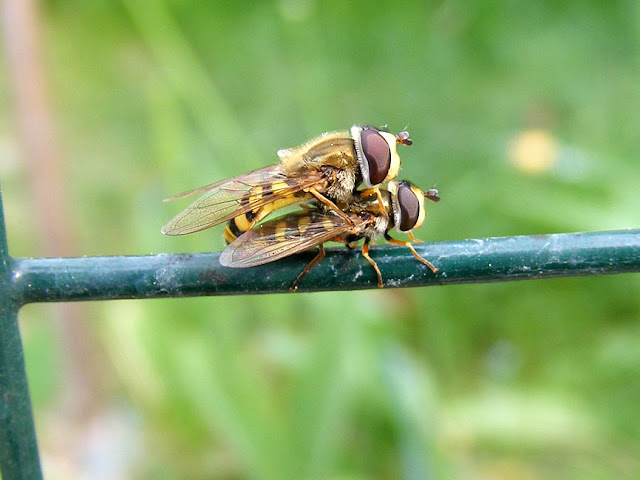Some of the local entomologists are gainfully occupying their time in lockdown by working on an inventory of hover flies in our Region of Centre-Val de Loire and Indre et Loire, our local 'county'. I was asked to contribute my records, which I did. I thought it was a good moment to highlight these attractive and important little flies on the blog. Hover flies are good pollinators, and many species have predatory larvae which feed on aphids, so you definitely want to be encouraging them in your garden. Here are a selection of the species you could see here in your garden, all photographed in our orchard.
Two for the price of one.
Above a Tapered Drone Fly Eristalis pertinax, below a Marmalade Hover Fly Episyrphus balteatus, nectaring on Ivy Hedera helix flowers. Drone flies are honey bee mimic hover flies. There are several species, quite similar looking, and you may have noticed them hovering at about head height in sunny spots in the spring. Both these hover flies are abundant, widespread and can be seen in every month of the year if it is not too cold.
Xanthogramma citrofasciatum.
A scarce species, associated with rough grassland with Yellow Meadow Ant Lasius flavus nests.
Migrant Hover Flies mating.
Eupeodes corollae, a very typical looking black and yellow stripey hover fly that is abundant in open areas of all sorts.
Hornet Mimic Hover Fly.
Volucella zonaria, one of the largest hover flies, they are often encountered in parks and gardens.
Milesia crabroniformis.
A very large hornet mimic, uncommon and completely harmless (like all hover flies, no matter what they are mimicking) nectaring on Wild Parsnip Pastinacus sativa.
************************************************
For details of our private guided tours of chateaux, gardens, wineries, markets and more please visit the Loire Valley Time Travel website. We would be delighted to design a tour for you.
We are also on Instagram, so check us out to see a regularly updated selection of our very best photos.
We are also on Instagram, so check us out to see a regularly updated selection of our very best photos.






7 comments:
Nice... and you finished with my favourite of all "Crabby Mellisa"....
Just for you, of course. I think she's probably our star species.
When looking at the first photo, I was wondering if the flowers they were nectaring on weren't those of Hedera helix and, sure enough, you gave the answer below! In Arlington, when my ivy is in bloom, the flowers are visited by zillion of insects of all kind.
And, sounding like a broken record, very interesting post!
Ivy is a really important nectar source and insects, especially flies, and ivy bees, flock to it.
Here in Western North Carolina, USA, we have many species of hoverfly and they are critically important to the ecology of our region. the other day I watched some aggregating near a small rock exposure - they are amazing mimics! Their sound gives them away, however, as their buzz is nothing like that of a true wasp or bee. One critical component of their survival is the presence of knotholes in deciduous trees (such as Fagus or Quercus species) that fill up with water seasonally - hoverflies and other syrphids love to lay their eggs in these "tree holes". Take a look in early spring next year and you'll find them teeming with (larval) life!
Yes, old trees are really important for them. It's rather fashionable amongst the clued up eco-gardeners in Europe to make up slurry buckets to tuck into a corner of the garden for hover flies to breed in.
Excellent!
Post a Comment